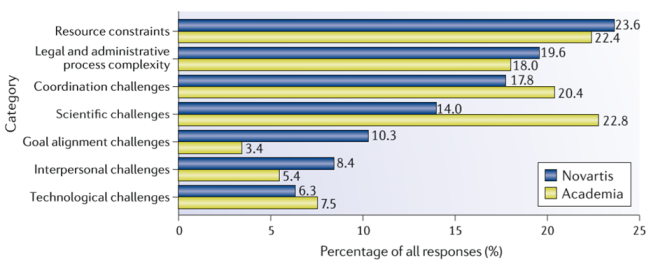Success Factors in Academia – Industry Collaborations
In order to develop into real world applications, translational projects matured in an academic environment can benefit from collaboration with industrial partners. The road to successful cooperation can however be challenging. In this article, the industry expert Guido Koch offers insights into the factors affecting the development of such partnerships and provides valuable tips on how to manage them.
In my role as an industry representative in the NCCR TransCure network, with background in both large pharma companies and biotech start-up ventures, I would like to share the key highlights of a very interesting study we recently conducted in an ETH Zürich – Novartis collaboration. The team led by Prof. Georg von Krogh from the Department of Management, Technology, and Economics at ETH identified challenges and success factors for academia industry collaborations that might be of more general relevance [1].
Challenges in collaborative projects
Although academia-industry partnerships are recognized as a good source of innovation and a key factor in advancing science in drug discovery, they are replete with challenges. Our results indicate seven categories of challenges in industry–academia collaborative projects.
The most frequently mentioned categories of challenges are resource constraints, followed by legal and administrative process complexity. Together with coordination hurdles and scientific complexity, these categories constitute 79% of all challenges identified by study participants (Figure 1).
Prevalence of challenges
Interestingly we found that the most frequently mentioned challenges do not relate to conflicting goals or cultural differences between industry and academia, but rather to resource constraints, legal and administrative process complexity, coordination and scientific challenges.
The good news is that, except for scientific and technological challenges, the challenges are usually within the control of the collaboration team and can be mitigated through more effective teamwork and project management.
Impact on project success
We analysed seven factors, each corresponding to one challenge category, and found that each showed a different impact on reported project success (Figure 2).
Lack of coordination is associated with the strongest negative relationship for project success.
Interestingly, the industry-academia collaborative projects turned out to be more successful if they involved a higher degree of exploratory research.
Legal matters are often portrayed as a major challenge to industry–academia collaboration. Our data suggests, however, that while complex legal contracting may be a hurdle in the setup, it does not impede a project once established.
On the way to success
Our study suggests that ‘conflicting incentives’ or ‘clashing cultures’ are not in fact key roadblocks to industry–academia collaboration. Adequate resource commitments, however, are critical for collaborative project success.
As many challenges we identified are under the control of scientists and managers, the study concludes with four concrete suggestions for effectively managing industry–academia collaboration:
- Evaluate and manage the collaboration portfolio
- Ensure high quality communication and coordination
- Accommodate changing needs
- Foster commitment and enthusiasm
Most importantly, scientific complexity is a positive key driver for project success!
Over the past decade, the numerous academia – industry relationships have led to the establishment of several successful collaborations. In most case, the primary aim was to facilitate the transition of innovative academic breakthrough discoveries into viable innovative therapeutics. In addition, the interdisciplinary setup of the joint project teams benefited strongly from the diverse cultures and expertise in the participating organizations, namely university labs and pharmaceutical industry as well as small biotech start-up companies, and led to superior project results.
During the current and last phase of the NCCR TransCure it will be important to let the translational aspects of the projects mature. Hence a well-designed approach towards selected collaborations with partners from industry might be an important focus of the network for the next years. The study results shared above might provide guidance to address some of the key success factors early on.
Dr. Guido Koch
Topadur Pharma AG, Schlieren
TransCure KTT committee, Industry representative
References
[1] Gersdorf T, Fang He V, Schlesinger A, Koch G, Ehrismann D, Widmer H & von Krogh G, Demystifying industry–academia collaboration, Nature Reviews Drug Discovery 18, 743-744 (2019), doi: 10.1038/d41573-019-00001-2





